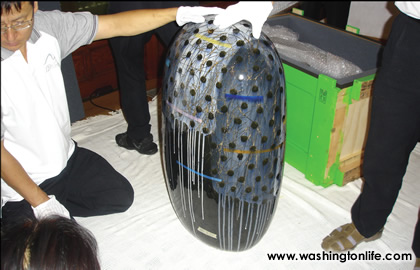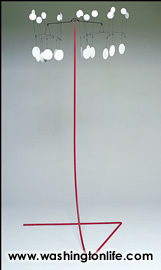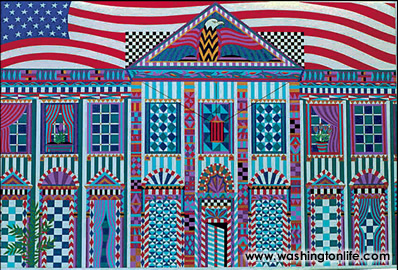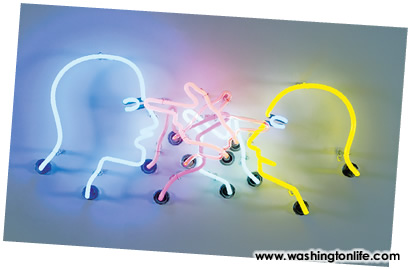The Fine Art of DiplomacyInside the State Department’s ART in Embassies programBY ROLAND FLAMINI A few days after her nomination as the next U.S. ambassador to Barbados Mary Ourisman trekked across the Key Bridge to deepest Rosslyn for her first diplomatic negotiation. In a high security office, she met with State Department staffers and discussed... art? Well, yes. Every ambassador designate does this: it is part of a crash course in diplomatic lore that also includes lectures on protocol, and a fake terrorist kidnapping in Virginia that will hopefully teach them how to avoid the real thing. Ourisman’s rendezvous was her first exposure to something the State Department definitely does right: the ART in Embassies program. As a result of this 42-year-old scheme she will take with her to Bridgetown a collection of American art works to decorate the reception rooms of the embassy residence during her tenure.
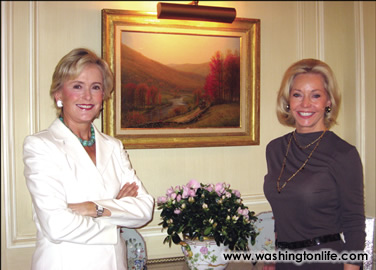 Anne S. Johnson, director of the ART in Embassies program, with Mary Ourisman, U.S. ambassador to Barbados, discussing the art she will take with her to Bridgetown. “The program’s aim is to showcase American art throughout the world,” says the effervescent Washington socialite and arts supporter. “It’s marvelous because not every ambassador has built up an art collection, and they would otherwise have empty walls.” Many countries put their cultural heritage on display in their embassies, but only the United States acts as official art dealer to enable every new envoy to choose what will hang on those empty walls. Miraculously, the practice of mounting what are in effect small exhibitions of works by American artists past and present in the spaces where ambassadors entertain has survived the quirks and whims of 13 secretaries of state from Dean Rusk to Condoleezza Rice. It is the envy of the diplomatic world. So far, someone has had the good sense to keep it separate from the disastrously undiplomatic public diplomacy scheme launched last year, and now seemingly and deservedly almost moribund in the dark depths of Foggy Bottom. The ART in Embassies program has flourished because it is functional, useful, and modest in the size of its operation — though not its scope. It is rooted in a tradition that helps keep museums in business — the loan system. “Neither a borrower nor a lender be, Polonius warns his son Laertes in Hamlet. But Polonius didn’t run the ART in Embassies program. What an art collector often takes years to build up, a newly appointed ambassador can accomplish in a couple of meetings with the ART in Embassy’s team of curators. The paintings, sculptures, works on paper, even quilts, are loaned free of charge by museums, commercial galleries, private and corporate collections, and by the artists themselves. In return, the lender gets the gratitude of the nation (anyway, of the administration) and of the ambassador, plus a small descriptive label beside each work in Beijing, London, or Ulan Bator. At the present time the program has 3,500 art works in 180 American embassies large and small, and in September, Mary Ourisman was one of 35 new envoys deciding on their respective choices. The wife of D.C. businessman Mandell Ourisman, the new ambassador to Barbados could well take pictures from her own private collection as many wealthy political nominees can, and sometimes do; but the program has been a boom to less well-heeled career diplomats. While each exhibition in some way reflects the ambassador’s tastes, ideas and requests, these are filtered through the program’s main considerations: the importance of the ambassadorial post in a highly structured pecking order, what’s obtainable, security, and local customs and certain conditions (no nude ladies in an Islamic country). The aim is to create a theme, a leitmotif that makes the works both attractive and plausible in the setting. “If we have 180 exhibitions, we have 180 themes,” says Anne Johnson, who is the Bush administration’s appointee to head the program.
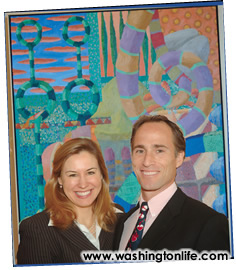  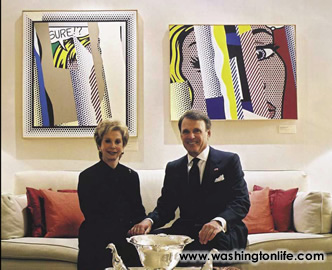 Above, left: Molly H. Bordanaro, the U.S. ambassador to Malta, and her husband Matt Bordanaro in front of a painting by Jack Portland. Above, right: Young children in Mozambique display the results of their June 2003 workshop with Therman Statom, a glass artist from San Diego who participates in the ART in Embassies program. Left: Stuart Bernstein, former U.S. ambassador to Denmark and his wife Wilma Bernstein in front of two paintings by Roy Lichtenstein they displayed during their time in Copenhagen. Clearly, dealing with some ambassadorial nominees is sometimes challenging to the program’s small staff, but to a visiting reporter that’s only suggested by innuendo — and no names, of course. A few ambassadors actually have their requests turned down outright. The nominee who asked for nothing but paintings of battles was among the more recent refusals. But the envoy who took with him to the U.S. interest section in Castro’s Havana paintings of caged birds and even a shark was allowed to make his symbolic political point. Generally what ends up getting crated and shipped to Rome or elsewhere is the result of give and take on both sides. “It’s fun and challenging when they come in with their long list, but we prefer an ambassador who is open to our suggestions,” says Virginia L. Shore, the program’s chief curator. “And you can quickly tell whether an ambassador is going to be receptive or not.” From the start, the ART in Embassies team liked Mary Ourisman’s notion of an “exhibition of coastal paintings,” which she called Sea to Shining Sea. She even had a wish list of paintings, with pictures cut out of magazines. “Landscapes of U.S. shorelines and also abstractions, she liked them both,” according to Robert T.Soppelsa, the curator assigned to the Ourisman exhibition. Ourisman, who was sworn in on October 11th says, “I got the idea when I was in La Jolla, and I saw an early painting of the California coastline in an art gallery. Barbados is an island, and the residence has a view of the ocean. I’m going to make it an island home, and I’m going to decorate it that way, with coral, and silver palm trees, and I think it makes sense to have views of the water and the lovely American coast.” Borrowing is the program’s lifeline, and getting the desired works requires as much tact as dealing with some ambassadors. “Each loan is a negotiation,” says Shore. “Every exhibition you’re coming up with a new set of paintings and a new set of lenders.” Museums are generally reluctant lenders because they don’t like to part with art works for three years, the average length of an ambassadorial appointment. They also have stricter rules regarding climate control and humidity, and generally take longer to make up their minds: still, the National Gallery, for example, currently has 15 paintings on loan to the program, including works by Winslow Homer, John Singer Sargent, and Childe Hassam. Among other museums currently in the program are the Whitney in New York, and the Los Angeles Museum of Contemporary Art. Art galleries and individual artists can move faster, liking the publicity, especially with Anne Johnson’s new wrinkle to the program of sending artists to the capitals where their works are on display to give lectures and meet local artists. Let’s face it, a Rothko on the wall is not going to solve the Palestinian-Israeli problem, yet at the very least these exhibitions remind the ambassadors’ foreign guests that there is much more to American culture besides Coca-Cola and Paris Hilton. They can also be good ice-breakers: when all else fails ambassadors can launch into a description of the art collection. And in the major U.S. embassies the resident exhibition is often worthy of a medium sized art gallery. At Winfield House, the residence of the U.S. ambassador in London, Ambassador Robert Holmes Tuttle has on display an impressive exhibition of icons of American art. The Paris residence now has a collection of contemporary paintings by Edward Hopper, Mark Rothko and Elsworth Kelly.
But the ART in Embassies staff shows its real mettle in constantly coming up with interesting displays for smaller embassies. "The range of what we show is amazing," says Shore. In 2003, the program installed for Ambassador Aurelia Brazeal a remarkable exhibition of African American art in Addis Ababa, with works coming mainly from a little known private collection which came to Shore’s attention through a chance meeting with its collector. nexplained hole in the canvas — over the years the ART in Embassies program has maintained a good safety record for the art works in its temporary care. There was a narrow escape in an African capital when a fire broke out in the embassy, and recently, a wall hanging returning home from Rabat, Morocco, was badly faded from exposure to too much direct sunlight. In an increasingly dangerous world, security is a constant anxiety, which is why insurance costs is one of the biggest items on the program’s budget. The shipment of an exhibition to Israel was held up for almost six weeks by the fighting in Lebanon. No outside lenders are keen to have their paintings blown up by al-Qaida rockets in Baghdad’s Green Zone. So for U.S. Ambassador Zalmay Khalilzad’s embassy residence in Iraq, the program has in effect sidestepped its own rules, buying and installing a permanent exhibition. At least Mary Ourisman's exhibition, when complete, will present fewer security anxieties. She expects to have her collection of 15 or so American works in place by the start of the December social season in Bridgetown, so she can show it off to visitors. If need be she can reinforce it with works from the Ourisman home, like their painting by Worthington Woodridge. But that, she says, is not what ART in Embassies is all about. |

